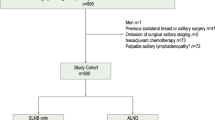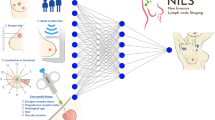Abstract
The purpose of the present study was toassess prognostic factors for metachronous contralateral recurrence ofbreast cancer (CBC). Two factors were of particularinterest, namely estrogen (ER) and progesterone (PgR) receptorsassayed with the biochemical method in primary tumortissue. Information was obtained from a prospective clinicaldatabase for 1763 axillary node-negative women who hadreceived curative surgery, mostly of the conservative type,and followed-up for a median of 82 months.The analysis was performed based on both astandard (linear) Cox model and an artificial neuralnetwork (ANN) extension of this model proposed byFaraggi and Simon [9]. Furthermore, to assess theprognostic importance of the factors considered, model predictiveability was computed.
In agreement with already published studies, the resultsof our analysis confirmed the prognostic role ofage at surgery, histology, and primary tumor site,in that young patients (≤ 45 years) withtumors of lobular histology or located at inner/centralmammary quadrants were at greater risk of developingCBC. ER and PgR were also shown tohave a prognostic role. Their effect, however, wasnot simple in relation to the presence ofinteractions between ER and age, and between PgRand histology. In fact, ER appeared to playa protective role in young patients, whereas theopposite was true in older women. Higher levelsof PgR implied a greater hazard of CBCoccurrence in infiltrating duct carcinoma or tumors withan associated extensive intraductal component, and a lowerhazard in infiltrating lobular carcinoma or other histotypes.In spite of the above findings, the predictivevalue of both the standard and ANN Coxmodels was relatively low, thus suggesting an intrinsiclimitation of the prognostic variables considered, rather thantheir suboptimal modeling. Research for better prognostic variablesshould therefore continue.
Similar content being viewed by others
References
Hislop TG, Elwood JM, Coldman AJ, Spinelli JJ, Worth AJ, Ellison LG: Second primary cancers of the breast: incidence and risk factors. Br J Cancer 49: 79–85, 1984
Kurtz JM, Almaric R, Brandone H, Ayme Y, Spitalier JM: Contralateral breast cancer and other second malignancies in patients treated by breast-conserving therapy with radiation. Int J Radiation Oncology Biol Phys 15: 277–284, 1988
Rutqvist LE, Cedermark LE, Glas U, Mattson A, Skoog L, Somell A, Theve T, Wilking N, Askergren J, Hjalmar ML, Rotstein S, Perbeck L, Ringborg U: Contralateral primary tumors in breast cancer patients in a randomized trial of adjuvant tamoxifen therapy. J Natl Cancer Inst 83: 1299–1306, 1991
Kelsey JL, Horn-Ross PL: Breast cancer: magnitude of the problem and descriptive epidemiology. Epidemiol Rev 15: 7–16, 1993
Horn PL, Thompson WD: Risk of contralateral breast cancer. Associations with histologic, clinical, and therapeutic factors. Cancer 62: 412–424, 1988
Gasparini G, Gullick WJ, Bevilacqua P, Pozza F, Lemoine NR, Meli S, Boracchi P, La Malfa G, Weidner N: Pathobiological characteristics of the first primary and risk of contralateral invasive breast carcinoma: clinical implications. Int J Oncol 2: 781–790, 1993
Silvestrini R, Daidone MG, Luisi A, Boracchi P, Mezzetti M, Di Fronzo G, Andreola S, Salvadori B, Veronesi U: Biologic and clinicopathologic factors as indicators of specific relapse types in node-negative breast cancer. J Clin Oncol 13: 697–704, 1995
Cox DR: Regression models and life tables (with discussion). J Royal Stat Soc, Series B 34: 187–220, 1972
Faraggi D, Simon R: A neural network model for survival data. Stat Med 14: 73–82, 1995
Veronesi U, Volterrani F, Luini A, Saccozzi R, Del Vecchio M, Zucali R, Galimberti V, Rasponi A, Di Re E, Squicciarini P, Salvadori B: Quadrantectomy versus lumpectomy for small size breast cancer. Eur J Cancer 26: 671–673, 1990
Schnitt SJ, Connolly JR, Harris JR, Hellman S, Cohen RB: Pathologic predictors of early local recurrence in stage I and II breast cancer treated by primary radiation therapy. Cancer 53: 1049–1057, 1984
Harrell FE, Lee K, Califf R, Pryor DB, Rosati RA: Regression modeling strategies for improved prognostic prediction. Stat Med 3: 143–152, 1984
Hanley JA, McNeil BL: The meaning and use of the area under a receiver operating characteristics (ROC) curve. Radiology 143: 29–36, 1982
Bishop CM: Neural Networks for Pattern Recognition. Clarendon Press, Oxford, 1995
Cleweland WS: Robust locally weighted regression and smoothing scatterplots. J Am Stat Assoc 74: 829–836, 1979
Chambers JM, Hastie TJ: Statistical Models in S. Chapman & Hall, New York — London, 1993
Hankey BF, Curtis RE, Naughton MD, Boice JD, Flannery JT: A retrospective cohort analysis of second breast cancer risk for primary breast cancer patients with an assessment of the effect of radiation therapy. J Natl Cancer Inst 70: 797–804, 1983
Schenker JG, Levinsky R, Ohel G: Multiple primary neoplasms in breast cancer patients in Israel. Cancer 54: 145–150, 1984
Prior P, Waterhouse JAH: Incidence of bilateral tumours in a population-based series of breast-cancer patients. I. Two approaches to an epidemiological analysis. Br J Cancer 37: 620–634, 1978
Schwartz AG, Ragheb NE, Swanson GM, Satariano WA: Racial and age differences in multiple primary cancers after breast cancer: a population-based analysis. Breast Cancer Res Treat 14: 245–254, 1989
Anderson DE, Badzioch MD: Bilaterality in familial breast cancer patients. Cancer 56: 2092–2098, 1985
Bernstein JL, Thompson WD, Risch N, Holford TR: Risk factors predicting the incidence of second primary breast cancer among women diagnosed with a first primary breast cancer. Am J Epidemiol 136: 925–936, 1992
Dixon JM, Anderson TJ, Page DL, Lee D, Duffy SW, Stewart HJ: Infiltrating lobular carcinoma of the breast: an evaluation of the incidence and consequence of bilateral disease. Br J Surg 70: 513–516, 1983
Rosselli Del Turco M, Ciatto S, Perigli G, Borrelli D, Carcangiu ML, Santucci M: Bilateral cancer of the breast. Tumori 68: 155–160, 1982
Fisher ER, Fisher B, Sass R, Wickerham L, collaborating NSABP investigators: Pathologic findings from the National Surgical Adjuvant Breast Project (protocol no.4). XI. Bilateral breast cancer. Cancer 54: 3002–3011, 1984
Stalsberg H, Thomas DB, Noonan EA, the WHO collaborative study of neoplasia and steroid contraceptives; Histologic types of breast carcinoma in relation to international variation and breast cancer risk factors. Int J Cancer 44: 399–409, 1989
Russo J, Russo IH: Development of the human mammary gland. In: Neville MC, Daniel CW (eds) The Mammary Gland. Plenum Publishing Corporation, 1987, pp 1–93
Sloane JP: Evidence for premalignant lesions in the human breast. Eur J Cancer 2: 17–21, 1993
Ricketts L, Turnbull L, Ryall G, Bakhshi R, Rawson NSB, Nolan C, Coombs RC: Estrogen and progesterone receptors in the normal female breast. Cancer Res 51: 1817–1822, 1991
Calaf G, Alvarado MV, Bonney GE, Amfoh KK, Russo JR: Influence of lobular development on breast epithelial cell proliferation and steroid hormone receptor content. Int J Oncol 7: 1285–1288, 1995
Cross SS, Harrison RF, Kennedy RL: Introduction to neural networks. Lancet 346: 1075–1079, 1995
Rumelhart DE, McClelland JL (eds): Parallel Distributed Processing: Explorations in the Microstructure of Cognition. Vol 1. Foundations. MIT Press, Cambridge, Massachussets, 1986
Hertz J, Krogh A, Palmer RG: Introduction to the Theory of Neural Computation. Addison-Wesley, Redwood City, CA, 1991, pp 124–129
Baxt WG: Application of artificial neural networks to clinical medicine. Lancet 346: 1135–1138, 1995
Author information
Authors and Affiliations
Rights and permissions
About this article
Cite this article
Mariani, L., Coradini, D., Biganzoli, E. et al. Prognostic factors for metachronous contralateral breast cancer: A comparison of the linear Cox regression model and its artificial neural network extension. Breast Cancer Res Treat 44, 167–178 (1997). https://doi.org/10.1023/A:1005765403093
Issue Date:
DOI: https://doi.org/10.1023/A:1005765403093




